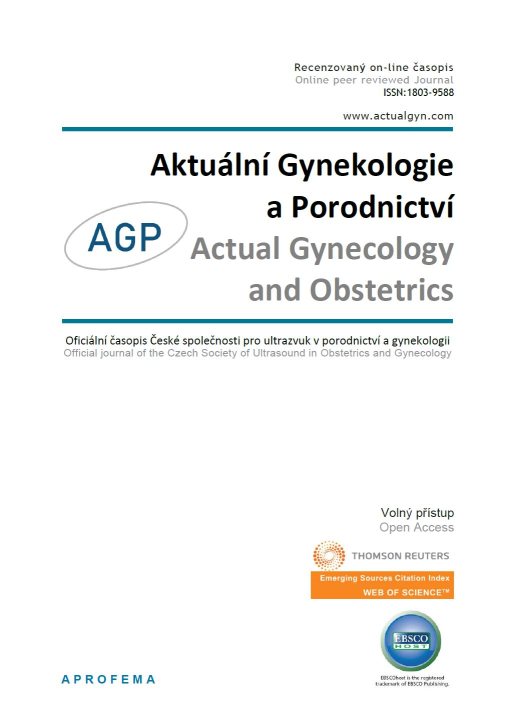











 Official publication of the Czech Society of Ultrasound in Obstetrics and Gynecology.
Official publication of the Czech Society of Ultrasound in Obstetrics and Gynecology.

In 2015 a sudden increase in the number of reported cases of microcephaly was reported in Brazil. At present, many sources suggest a connection between these cases and infection with the Zika virus. Although there have been several published case reports in which the Zika virus was found in affected women and their fetuses and newborns, the methodology used in diagnosis of many such cases is in doubt. The causal link between Zika infection and fetal anomaly has not been definitely, or even convincingly, demonstrated to date. The global campaign, aimed at improving the diagnosis, prevention, and possible treatment of Zika infection, was initiated on insubstantial evidence. Well-designed studies, and not just case reports, will be necessary to confirm and demonstrate the actual link between maternal infection and fetal anomaly. Likewise, the exact risk of vertical transmission and its fetal effects must be conclusively demonstrated. That there is a threat posed to the fetus by maternal Zika infection is certainly a possibility, but while there is so little real evidence, coincidence or too-rapid jumping to conclusions might be equally at work.
We are witnessing a massive media campaign where on one hand there is a little convincing scientific evidence indicating a relationship between the Zika virus infection and fetal damage, while on the other hand the situation has a far-reaching impact on our daily lives. Some local authorities recommend women from the areas where Zika occurs to delay pregnancy, and people in the remaining parts of the world are advised by global authorities such as the WHO or CDC how to behave in specific situations and urged to reconsider traveling to areas where Zika occurrence has been reported.
The Zika virus is an arbovirus from the Flaviviridae family and is one of the four tropical viruses transmitted by arthropods; the other three are dengue fever, West Nile virus and chikungunya. The virus was named after the Zika forest in Uganda where it was first identified in 1947 in a rhesus macaque monkey (1). Until recently, the occurrence of this virus was confined to a very narrow equatorial belt crossing Africa and Southeast Asia. Over the past ten years the virus has spread from Polynesia to Easter Islands and further to Chile, Brazil, Columbia, Surinam, Central America, Mexico and the Caribbean. Environmental changes, climate changes or virus mutation are suggested as supporting or causative factors connected with the virus’s circulation.
This RNA flavivirus is transmitted by the Aedes aegypti mosquito and has an incubation period of 3-12 days. The infection is asymptomatic in 75-80% of cases, with the rest of those infected only showing mild symptoms. The following symptoms may occur, individually or in combinations: high temperature, arthralgia and myalgia, maculopapular rash starting in the face and spreading to the entire body, mild conjunctivitis, headache and weakness (2). Similar symptoms are observed in a mild dengue or chikungunya virus infection. In some areas, such as French Polynesia and Brazil, the post- infection condition was accompanied by the Guillain-Barre syndrome (a rare autoimmune disorder affecting the nervous system with symptoms such as weakness and tingling in the limbs and sometimes overall weakness). Clinical diagnosis of the Zika virus infection is complicated, and it has so far not been possible to establish the etiological agent by any commercial serological or molecular diagnostic method.
The symptoms of the disease are mild and unspecific, typically last less than a week, and hospitalization is not required. Transmission of Zika to a human has so far not been reported in any European country, but the WHO recommends screening of travelers from endemic areas.
Apart from mosquitoes, the virus can be transmitted by sexual intercourse, blood transfusion or vertically from a mother to her fetus during pregnancy and childbirth.
In February 2015 a mild viral infection spread in northeast Brazilian states, sometimes accompanied by a rash and arthralgia. It must be noted that Brazil is the fifth most populated country in the world and the largest and most populated country of South America, with approximately 208 million inhabitants. In May 2015 the mosquito-borne Zika virus was identified as the cause of the infection. On 11 November 2015 the Brazilian Ministry of Health declared that 10 times higher fetal microcephaly occurrence than normal had been reported in Zika-affected areas (3).
Six days later, on 17 November 2015, the Brazilian Ministry of Health reported that Zika virus RNA was detected by PCR in two women with microcephalic fetuses (4). On the same day the WHO issued a warning about increased microcephaly occurrence in northeastern Brazil. Several days later the authorities in French Polynesia reported at least 17 brain malformation cases identified (by intra-uterine examination) in fetuses or newborns in connection with the Zika virus.
In December the CDC reported the occurrence of one Zika virus infection case in Puerto Rico, and on 15 January 2016 the CDC issued a recommendation for pregnant women to postpone traveling to Mexico, Puerto Rico and parts of Central and South America. This recommendation was extended to parts of the Caribbean and Polynesia on 22 January. An official medical recommendation for women to delay pregnancy until 2018 was issued in Salvador.
Occurrence reported in Brazil
The mechanism behind the rapid increase in microcephaly cases in Brazil is rather unclear, and the causes can only be speculated on. On the one hand, it is possible that the sporadic occurrence of microcephaly thus far has been under-reported due to a faulty reporting system (registry of birth defects). After all, we know only too well that even in this country there are issues with the system of registration and reporting; sometimes we are not even able to count the actual number of children born per year, and the calculations are off by hundreds (not to mention the registration of birth defects). With a country as large as Brazil, with its huge social differences and uneven healthcare levels, much greater issues with reporting can be expected. It is thus possible that the number of microcephaly cases had been first underreported, which would explain the unnaturally low microcephaly occurrence before 2015 (approximately 0.5 cases per 10,000 children born alive, which was lower than the expected estimate of 1–2 cases per 10,000 children born alive). In the second half of 2015, after the Ministry of Health started to pay more attention to the issue and required completing a relevant questionnaire on country-wide basis, the number of detected cases soared within a very short period of time to ten times the previous number. Soon enough, more than 3,000 suspected microcephaly cases were reported, i.e. 20 cases per 10,000 children born alive. This rather suggests that the reporting might originally have been inadequate, so once the reporting system was improved and applied consistently, the number of reported cases increased, but possibly only “on paper”. Another issue is the audit of the reported microcephaly cases, as it is quite possible that in some cases, especially the marginal ones, it may not have been a microcephaly at all (5). Before 2015, measuring fetal head circumference was not part of the routine prenatal checkup, and no records were available; it is therefore just possible that marginal or minor cases were not reported at all. For the reported cases, it cannot be proven whether the pregnant women had Zika or not. Laboratory diagnosis is not available as a standard, so information about the possible infection was based on reporting any rash or mild viral infection. Furthermore, nothing is known of other characteristics of the disease, such as hepatosplenomegaly, chorioretinitis or rarely reported serious effects such as loss of hearing, skin macules or swallowing difficulties.
Microcephaly diagnosisMicrocephaly, i.e. head size below the bottom level for the given age, is a very rare disease which receives virtually no attention in the Czech Republic. During fetal life, microcephaly should only be diagnosed if the head circumference (HC) is below 3 SD for the relevant gestational age. It is not entirely clear what effects a small head, if diagnosed, may have on the child’s development. Primary microcephaly is a disorder of cell proliferation while secondary microcephaly is acquired (6). Both conditions may present in utero. Pure (or non-syndromic) microcephaly should be distinguished from syndromic microcephaly. The association of other anomalies may aid in prenatal diagnosis, while isolated microcephaly may be difficult or even impossible to diagnose before the third trimester, as the second-trimester HC measurements are normal for many fetuses (7). Another point of controversy is the significance of a small HC in determining fetal growth restriction (FGR); i.e. whether the prognosis is better when compared with absolute or relative microcephaly. The head size may also be hereditary (parents with small head circumferences). There is a significant correlation between the child’s HC at birth and the HC of the mother. Children whose parents have smaller heads are born with smaller heads too (8).
Measuring HC in utero shows no adverse neuropsychological outcome for children with a fetal HC in the range of −2 SD to −3 SD. Furthermore, there is a high probability that postnatal HC will be within the normal range. Therefore, it has been proposed that microcephaly should not be diagnosed in utero in this HC range and that during counseling parents should be told that the developmental prognosis is good. It has been suggested that the definition of fetal microcephaly should be reserved for those with a HC smaller than – 3 SD. However, no accurate prognosis can be given in these cases either, and based on available studies (9, 10) the risk of postnatal mental retardation remains unknown.
There is very limited information about the Zika virus infection in pregnancy. There is no proof that pregnancy is predisposed for Zika virus infection or that the course of the infection is worse than in non-pregnant women. Vertical infection, i.e. from mother to fetus, is possible. Case studies have recently been published that document microcephaly occurrence in children of infected mothers (11, 12, 13).
For pregnant women who had traveled to pandemic areas and for whom fetal microcephaly, brain calcifications, or eye anomalies and/or cerebellar hypoplasia have been diagnosed, the possibility of having contracted Zika virus should be eliminated by amnio-PCR. The probability of this combination in the Czech Republic is very small.
Connection between viral infections and CNS defectsThe information published so far does not provide answers as to the connection between Zika infection of the pregnant woman and a possible vertical transmission from the mother to the fetus: how often the virus is transmitted and, if it is, how often the disease is manifested in the fetus in utero (14). There are only a few sporadic case studies where the virus has been detected in fetuses with microcephaly (15). However, this does not say anything about the causality of this diagnose, i.e. whether there are fetuses that have the Zika infection but do not show symptoms of the disease. Another question is, whether microcephaly should be associated with Zika infection at all, because there are only a few case studies available. Also, information regarding the disease’s impact on other organs than the brain of the fetus should be published.
Other possible implications of the global media campaignIn connection with the occurrence of the Zika virus infection, the following topics are covered in the media:
Surely the present campaign is a strong motivation for producing a test that would allow the Zika virus infection to be detected in everyday clinical practice; so far no such test is available.At least 3 pharmaceutical companies are known to be considering, or actively working on producing a vaccine, including the multinationals Glaxo Smith Kline and Sanofi. However, the company that seems to be closest to success is a relatively small biotechnology firm named Inovio Pharmaceuticals.Family planning is a separate chapter. In most countries with Zika virus occurrence, there is limited (or no) access to contraception (due to strict Catholic attitudes that are dominant), inadequate sexual education and strict anti- contraception legislation. In the whole of Central and South America, there are only 3 countries where interruption is legal (Uruguay, Guyana, French Guyana). Everywhere else in the region, termination of pregnancy is only permitted in the event of rape or incest, or if the mother's life is in danger. Only Mexico, Columbia and Panama allow mothers to terminate pregnancy due to congenital defects of the fetus. In countries such as Salvador, abortion is prohibited in all cases, even when the mother has been raped or her life is in danger; and it was in Salvador that the government issued a recommendation for women to delay pregnancy until at least 2018. How they are supposed to do this effectively is unclear. Not only is contraception barely accessible, but post-coital contraception is often illegal. 18% of children in Latin America are born to juvenile mothers, while Amnesty International estimates that more than 50% of the pregnancies in the region are unplanned.Based on the information available, I am convinced that visitors to the Olympics will face quite different risks than contracting the Zika virus (such as crime and other, common infections including alimentary ones).
Leaving aside the circumstances of the Zika virus media epidemic, there may be some positive implications: it will be easier to allocate funds for the production of the vaccine and diagnostic tests, and it may open the discussion on the possibilities of effective family planning in countries where this issue has been more or less taboo. For the organizers of the Olympics the present negative media coverage may pose a complication, but they will probably cope with that.
In 2016 Rio de Janeiro is to host the Summer Olympics (16). The warnings issued by national and international authorities contain, among other things, recommendations to reconsider attending the Olympics due to the Zika virus infection.
Quite understandably national and international organizations, whose job it is to protect population from infection diseases, take such threats very seriously and address them immediately. But I would expect them to submit the available information to a very detailed critical analysis, as I did before writing this article. Unfortunately, these organizations, without having sufficient evidence, respond by issuing complex and serious recommendations which have no rational basis (for example, warning people not to travel to the endemic areas, while there is a whole range of other dangerous diseases in these areas, as well as other risks such as relatively high crime rates).
Mosquitos transmitting the disease occur in the endemic areas mostly during the daytime, and protection against them can be provided by insect repellents containing DEET (diethyl-toluamid), picaridin and IR3535. These substances should be safe for use during pregnancy. Physicians should ask pregnant women, when determining their case history, whether they travelled into endemic areas during pregnancy. Testing should be offered only to symptomatic pregnant women, within 2 weeks from returning from the places of Zika virus occurrence; these women should also be tested for dengue and chikungunya (18).
So far there are no commercial tests for Zika virus infection. Laboratories use RT-PCR technologies, as well as antibody tests. Interpretation of the test results may be difficult, possibly requiring specialist consultations (National Institute of Public Health, reference laboratories). For symptomatic pregnant women, the fetus should be examined by ultrasound, irrespective of the result of the test for Zika virus presence. Sonography should also be carried out for asymptomatic women who have reported travel to endemic areas during pregnancy. If microcephaly or intracranial calcification is determined, it is possible to attempt amniotic fluid diagnostics, using PCR. The sensitivity and specificity of such testing is not known. If the fetal ultrasound examination is normal for pregnant women with positive tests for Zika virus, the ultrasound examination should be repeated every 3 to 4 weeks. If the Zika virus test is positive, a specialist should be consulted. After the birth, evidence of the virus should be sought in the placenta, umbilical cord and umbilical cord blood. Zika virus infection should also be excluded or confirmed for newborns, who should receive appropriate care.
So far there is no prevention or treatment for the Zika virus infection.
Well-designed studies rather than case reports will be necessary to confirm and conclusively demonstrate the actual link between maternal infection and fetal anomaly. In the same way, it has to be determined in what percentage transmission to the fetus in utero occurs, and what the probability is that the fetus actually develops the disease. (20)
The current media hysteria based solely on hypothetical information without scientific evidence must be rejected, at least until accurate information is gained that would justify any conclusion. That there is a threat posed to the fetus by maternal Zika infection is certainly a possibility, but while there is so little real evidence, coincidence or unjustified haste in jumping to conclusions might equally be at work.
With support from the Ministry of Health of the Czech Republic – RVO VFN64165.